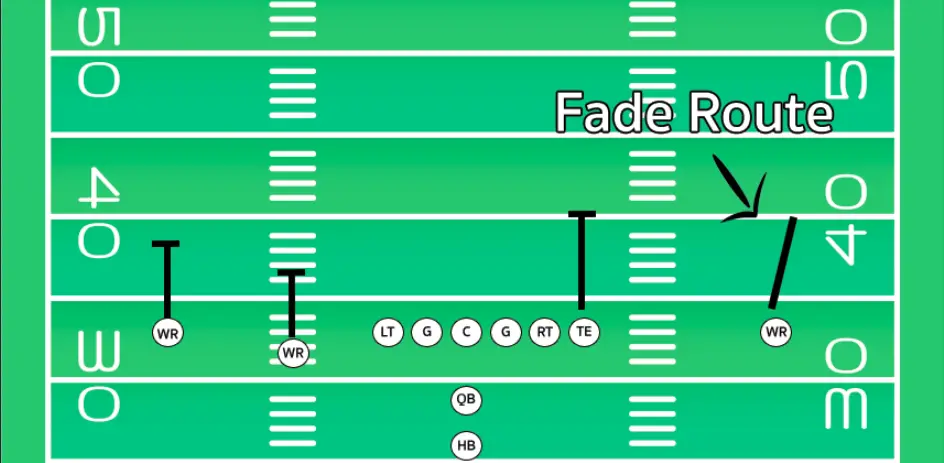Between all the positions, plays and routes football terminology can get a little confusing. Luckily for those of you wondering what a goal-line fade is in football you’re in the right place.
A goal line fade or a fade route in football is a short-yardage route that relies on the wide receivers’ ability to win a jump ball.
In essence, a back-shoulder fade route is less about generating separation and more about the receiver winning a one on one jump ball.
This is why these fade routes are thrown almost exclusively to a teams top receiver.
On a goal line fade the wide receiver will start the route by doing a quick stutter step to gain a small amount of separation. The receiver will then run towards the back corner of the endzone.
As the receiver runs toward the corner of the endzone the quarterback will throw a lob pass to him.
The receiver will then turn inwards toward the quarterback and jump up for the ball. It is key the receiver high points the ball as the defender will usually be close enough to get a hand on it if it is not high pointed.
What To Know About Goal Line Fades
Now that you know what a goal line fade is in football it’s time to learn a little more about them. Below we are going to break down a few things you need to know about goal line fades in football.
They Are Diminishing In Popularity
Goal line fades used to be one of the most common plays used when a team was close to the goal line.
Nowadays the goal line fade has become much less popular in the NFL. The reason for the decrease in goal line fades in football is due to analytics.
After NFL teams began to run the numbers regarding success with goal line fades they found that they were higher probability options they could use instead. This resulted in a noticeable drop in goal line fades across the NFL.
More common options in the red zone include slants, flat routes, and running plays.
Its All About The Matchup
The biggest factor that goes into running a goal-line fade is the matchup between the receiver and the cornerback.
The key to having a successful goal-line fade is winning the contested catch between the cornerback and the wide receiver.
This is why goal-line fades are almost exclusively thrown to tall and strong wide receivers. These players have an advantage on this route as they are typically going to be more successful at contested catches.
If the matchup is against a short or inexperienced corner this makes a goal-line fade even more enticing.
Often Used In Time Sensitive Situations
One more thing you may want to know about goal-line fades is that this route can be a handy tool when looking to conserve time.
Oftentimes late in a game a team will find themselves attempting to score without burning too much time on the clock.
When a pass is thrown incomplete in the NFL the game clock is stopped. This means that by throwing an incomplete pass you do not have to worry about time coming off the clock.
For this reason, if a team is close to the goal line with limited time it is not uncommon to try a goal-line fade. This low-risk play will burn only a few seconds off the clock and will give your team a decent chance to score a touchdown.

